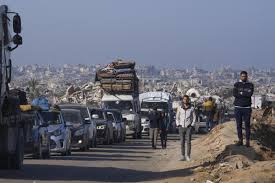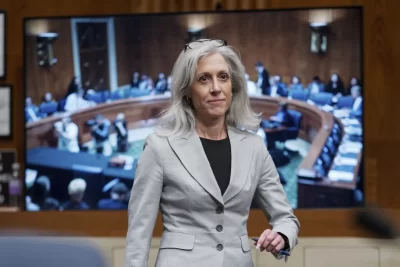
CAIRO — A top Hamas leader says the militant group will release six living Israeli hostages on Saturday and the bodies of four others on Thursday, a surprise increase that apparently comes in return for Israel allowing mobile homes and construction equipment into the devastated Gaza Strip.
The six are the last living hostages set to be freed under the ceasefire’s first phase. The warring sides have yet to negotiate the second and more difficult phase, in which Hamas says it will release dozens more hostages in exchange for a lasting ceasefire and an Israeli withdrawal.
Hamas leader Khalil al-Hayya, in prerecorded remarks, said the “Bibas family” would be included in the handover of four bodies, apparently referring to Shiri Bibas and her two young sons, Ariel and Kfir, who for many Israelis embody the captives’ plight.
Israel has not confirmed their deaths, and the prime minister’s office urged the public not to distribute “photos, names and rumors.”
Israel has said it was gravely concerned about the Bibas family, while Hamas said they were killed in an Israeli airstrike early in the war. Yarden Bibas, the husband and father, was kidnapped separately and released this month.
Kfir, who was 9 months old at the time, was the youngest hostage taken in Hamas’ Oct. 7, 2023, attack that triggered the war. A video of the abduction showed Shiri swaddling her redheaded boys in a blanket and being whisked away by armed men.
An Israeli official, speaking on condition of anonymity in line with regulations, said Prime Minister Benjamin Netanyahu had agreed to allow long-requested mobile homes and construction equipment into Gaza as part of efforts to accelerate the hostages’ release.
Hamas last week threatened to hold up releases, citing the refusal to allow in mobile homes and heavy equipment among other alleged violations of the truce.
Israel is expected to continue releasing hundreds of Palestinian prisoners, including many serving life sentences for deadly attacks, in exchange for the hostages. Others were detained without charge. During the first phase, Israel is also due to release all women and children seized from Gaza since the war began.
Palestinians want to stay in their homeland
The ceasefire that began in mid-January has paused the deadliest fighting ever between Israel and Hamas, surged aid into devastated Gaza and allowed hundreds of thousands of Palestinians to return to their homes as Israeli forces withdrew from much of the territory.
Israelis and Palestinians marked 500 days of war on Monday.
Major challenges are ahead. Israel’s government says it wants to eliminate Hamas’ military and governing capabilities in Gaza. But the militant group quickly reasserted its control of the territory during the ceasefire despite losing leaders and many fighters.
In addition, U.S. President Donald Trump ’s proposal to permanently remove Gaza’s population of some 2 million Palestinians so the U.S. can redevelop the territory has been rejected by the Arab world and by the Palestinians, who say they want to stay in their homeland. Egypt is working on a counter-plan to rebuild without moving Palestinians.
Israel has embraced the plan, and it and the Trump administration have emphasized they share the same goals in the war.
Israelis were horrified by the sight of three emaciated hostages in an earlier release this month, and revelations about hostages being held alone, barefoot or in chains have increased the pressure on Netanyahu’s government to push ahead with the ceasefire’s next phase. A number of Palestinians released from Israeli prisons have shown emaciation, and some have reported abuses including beatings.




